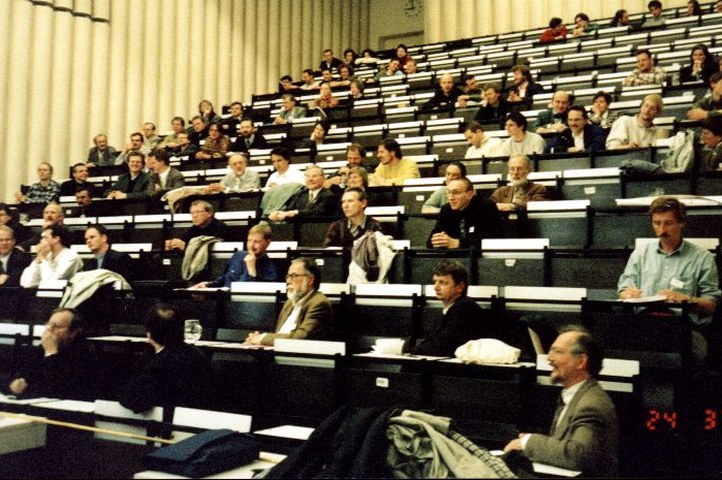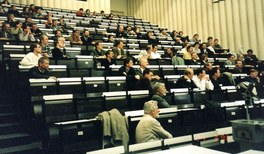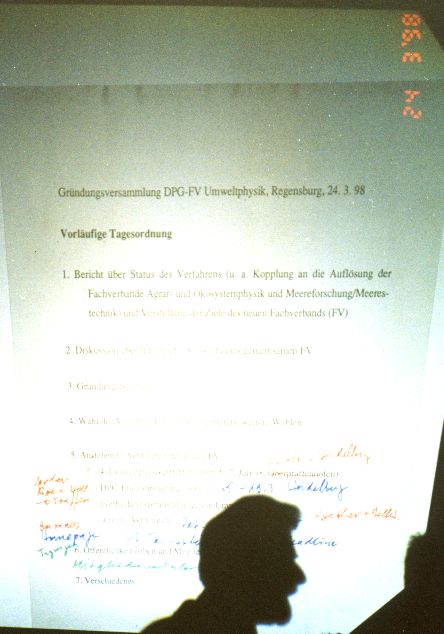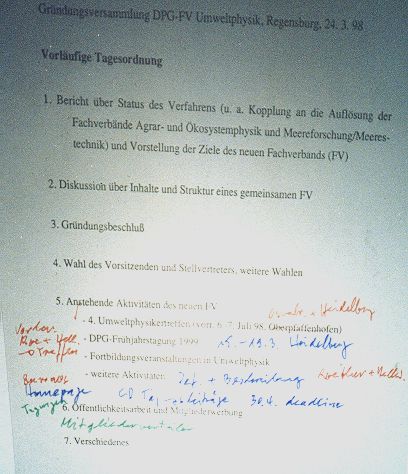About us
The History of Environmental Physics in the DPG
~ A different quality of physics ~
About the founding of the professional association by W. Roether (from: Phys. Bl. 54 (1998) Nr. 7/8 S. 577; translation by google translator)
At its 62nd spring meeting in Regensburg, the DPG expanded its professional spectrum by founding an “Environmental Physics” specialist association, which also presented itself there with a special symposium “Physics for the Environment” (see article “Opinion”). The symposium provided an example of how environmental physicists understand their work, namely as research into the Earth system using physical methods. The focus is on the subsystems that form the tangible human environment, i.e. the atmosphere, the hydrosphere including groundwater and cryosphere, the soil, and the biosphere; Overarching aspects include climate, material and energy flows, and ecosystems (see Phys. Bl., February 1997, p. 106). The aim can be described as the motto: "If you want to deal with the environment rationally, you must first understand it."

While environmental physicists see themselves as "full-blooded physicists", their research approaches and methodologies show clear differences from those of traditional physics. Typical for the latter is a preoccupation with isolated, fundamental phenomena in laboratory studies and/or within the framework of closed theories and thematically concentrated on a specific sub-area of the classical physics canon - as can also be seen from the names of the majority of the DPG specialist associations (of 501 core - and high energy physics to 537 surface physics). Environmental physics, on the other hand, touches on several of these sub-areas and works systemically. Typical are complex measurement campaigns in the field under conditions dictated by nature, as well as semi-empirical modeling and theory development that takes into account the systemic nature of the environment. In addition, their work is often interdisciplinary.
Surprisingly, it is only very recently that environmental physicists have begun to view themselves as an independent group within physics and to organize themselves as such, even though work in environmental physics is (as we understand it today) older than the term "environment" itself. Such work began with the application of physical methods in neighboring disciplines of physics, such as 14C age determinations for hydrology. Physicists now work “full-time” on the environmental subsystems mentioned. Their work often differs little from that in traditional disciplines such as meteorology or physical oceanography, although methodologically it is usually more closely aligned with physics. In practice, there is a cooperative coexistence between environmental physics (now organized in the DPG) and neighboring disciplines (with their own scientific societies), which needs to be maintained.
According to the textbook, environmental physics as outlined above is a branch of geophysics. De facto, however, German geophysics predominantly works on the solid earth, i.e. a complement to the subjects of environmental physics. The corresponding English usage covers environmental physics more clearly, which is reflected, for example, in the fact that the "European Geophysical Society" (EGS) represents an important forum for many of the German environmental physics working groups. Apparently, there have also been areas in the DPG that can be attributed to environmental physics in the broader sense. These include the specialist associations for Extraterrestrial Physics and Radiation Effects/Radiation Protection as well as the Energy Working Group. While cooperation was agreed upon with these, two smaller specialist associations, namely Marine Research/Marine Technology and Agricultural and Ecosystem Physics, were merged into the Environmental Physics Specialist Association. This aims to represent its members and promote scientific interactions across their entire subject area and wants to do without formal sub-groups. This is intended, among other things, The fact must be taken into account that many of its members will continue to present more specialized questions at conferences of other scientific societies, e.g. at the EGS. A first practical test for this demarcation and for the interactions within the professional association as well as with the above-mentioned and other professional associations of the DPG will take place at the 63rd spring conference next year in Heidelberg.
 |
 |
 |
As was also shown in Regensburg, there are numerous institutes and working groups focused on environmental physics in Germany. In addition to the environmental physicists working there, others can be found "scattered" in industry and administration as well as in scientific institutions of other disciplines. The professional association wants to offer all of these a scientific home, which will probably bring new members to the DPG. Our primary concern, however, is to give greater weight to environmental physics through a broad organization within the DPG. We associate this with expectations such as expanded career opportunities for our graduates and an increased role of environmental physics in the updating of university curricula in physics and the professional orientation of the physics faculties. The success of our symposium in Regensburg and a lot of positive feedback was an encouraging start for the Environmental Physics Association.
More about the beginnings of the Environmental Physics division [in German] (W. Roether, 2019)